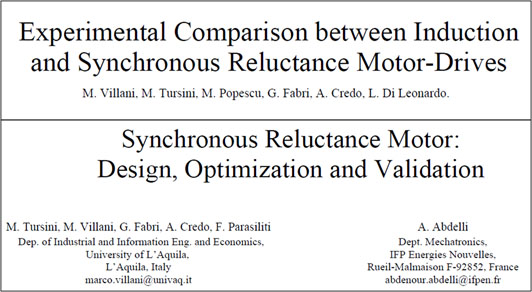ReFreeDrive project’s activities and results have been published throughout 2018 on various international conferences. As a result, now you can find two conference papers about electric motors available for download at our publications section, both written by University of L’Aquila with the collaboration of Motor Design Limited (M. Popescu) and IPF Energies Nouvelles (A. Abdelli)
You can find the complete reference of the articles, as well as a brief summary of each of them below:
Title: Experimental Comparison Between Induction and Synchronous Reluctance Motor-Drives
Authors: M. Villani; M. Tursini; M. Popescu; G. Fabri; A. Credo; L. Di Leonardo
Conference: 2018 XIII International Conference on Electrical Machines (ICEM)
DOI: 10.1109/ICELMACH.2018.8506983
Abstract: Induction motor and synchronous reluctance motors are promising solutions in different variable speed applications requiring high performance at low cost. Indeed these motor technologies are not based on rare earth Permanent Magnets saving the associated costs and supplying concerns. This paper presents a comparative analysis of these two motor solutions supported by experimental results: the motors are fed by a variable speed drive executing suitable control algorithms to maximize torque and motor efficiency. The comparative analysis considers the same stator for the two motor technologies and different rotors. Simulation analyses are performed by mean of a Finite Element Tool and supported by experimental tests.
Download link: here
Title: Synchronous Reluctance Motor: Design, Optimization and Validation
Authors: M. Tursini; M. Villani; G. Fabri; A. Credo; F. Parasiliti; A. Abdelli
Conference: 2018 International Symposium on Power Electronics, Electrical Drives, Automation and Motion (SPEEDAM)
DOI: 10.1109/SPEEDAM.2018.8445304
Abstract: The growing demand of high-performance motors requires the definition of more accurate design procedures. The only possibility to obtain such kind of results is to combine Finite Element programs with optimization procedures. For this reason, a multi-objective optimization algorithm has been developed, and it has been used to design a Synchronous Reluctance Motor with flux barriers rotor, starting from the stator core of a commercial three-phase induction motor of equivalent size. Based on the optimization results, a prototype has been built and tested.
Download link: here


Comentarios recientes